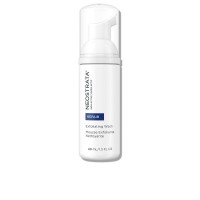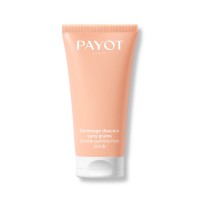Esfoliante, Peeling

As diferenças entre esfoliação e Peeling químico
A renovação regular da pele é essencial. Importante saber qual o método a adotar: esfoliação ou peeling químico (descamação)?
Para ter uma pele clara e suave, a esfoliação é essencial. Sendo este um processo mecânico, limpa com partículas, como o açúcar. Difere do peeling químico cujo processo utiliza químicos, para provocar a descamação da pele.
Esfoliação
Por esfoliação, entendemos a eliminação de células mortas que permanecem na superfície da epiderme. Este tratamento facial faz parte de uma boa rotina básica de beleza, para suavizar a pele e facilitar a absorção dos produtos hidratantes, aplicados posteriormente. Recomenda-se esfoliar uma vez por semana para não fragilizar a epiderme e, assim, não causar distúrbios na produção de sebo. De fato, essa prática pode danificar o filtro hidrolipídico, se realizada com muita frequência. Quando menos protegida, a pele fica mais vulnerável a agressões externas.
O esfoliante funciona graças à sua composição, mas acima de tudo, dos movimentos realizados com os dedos. Apresentado na forma de gel ou creme, contém partículas que permitem desobstruir os poros. Para ativar esse efeito, basta fazer movimentos circulares, evitando a área dos olhos e adaptando a massagem à tolerância da pele. Essa técnica permite uma limpeza profunda, ideal para purificar e remediar pequenas imperfeições, como cravos. Também reativa a microcirculação e estimula a regeneração celular. Qualquer que seja o tipo de pele, você deve sempre escolher um produto macio, não muito abrasivo, que respeite o equilíbrio natural da epiderme.
Peeling químico ou descamação
Para uma pele com casca, deixamos o produto químico fazer todo o trabalho, como os ácidos que causam esfoliação química. No entanto, essa não é uma solução fácil. Dependendo do grau escolhido, superficial, médio ou profundo, as consequências para a pele podem ser radicais. Por exemplo, o mais profundo "é extremamente forte e deve ser realizado na sala de cirurgia sob anestesia", explicou o cirurgião plástico Alexandre Duvernois. Este processo agressivo é bastante recomendado para mulheres maduras, uma ou duas vezes por ano, para renovar a pele e apagar rugas. Os tratamentos de descamação, com uma leve concentração, geralmente à base de ácido glicólico a 10%, não precisam ser realizados por um cirurgião plástico ou por um dermatologista. Estão disponíveis e podem ser aplicados em casa para eliminar a pele morta e recuperar uma pele fresca. No entanto, continuam a ser agressivos e podem não ser adequados para peles sensíveis. É sempre essencial testá-los antes de aplicá-los em todo o rosto.
Novos 'Esfoliante, Peeling' à venda
Annayake Radiance Exfoliator
Annayake Radiance Exfoliator: A Revolução da Luminosidade em Portugal Descubra o segredo para..
33,95€
Anne Möller Clean Up Energizing Citric Scrub
Anne Möller Clean Up Energizing Citric Scrub é o esfoliante facial ideal para quem busca uma pele ma..
19,95€ 27,00€
-26%
Anne Möller Perfectia Night Progressive Peeling Cream
Anne Möller Perfectia Night Progressive Peeling Cream é a solução definitiva para quem busca uma pel..
36,95€ 52,00€
-29%
Annemarie Borlind Effekt Peeling
Descubra a Revolução em Cuidados com a Pele: Annemarie Borlind Effekt Peeling O Effekt Peelin..
27,95€
Atashi Cellular Cosmetics Supernight Desmaquillante Exfoliante Gel to Milk
Atashi Cellular Cosmetics Supernight Desmaquillante Exfoliante Gel to Milk Descubra a experiência l..
13,95€ 18,95€
-26%
Atashi Radiant Instant Skin Anti-Fatigue
Atashi Radiant Instant Skin Anti-Fatigue é a solução inovadora que a sua pele cansada precisa. Formu..
16,95€ 22,10€
-23%
Avène Cleanance Sérum Esfoliante AHA
Avène Cleanance Sérum Esfoliante AHA Descubra a eficácia do Avène Cleanance Sérum Esfoliante AHA, a..
31,95€ 45,15€
-29%
Avène Gelée Gommante Douceur
Avène Gelée Gommante Douceur é um esfoliante suave, ideal para quem busca uma limpeza profunda sem a..
21,95€ 27,46€
-20%
Babor Clarifying Peeling Cream
Babor Clarifying Peeling Cream - Esfoliante Facial de Limpeza Profunda Experi..
17,95€
Babor Gentle Peeling Cream
Babor Gentle Peeling Cream é um esfoliante facial de alta qualidade desenvolvido para oferecer uma l..
17,95€
BareMinerals Ageless Phyto-AHA Radiance Peeling
BareMinerals Ageless Phyto-AHA Radiance Peeling: O Segredo para uma Pele Radiante Descubra o poder ..
40,95€ 53,00€
-23%
Bella Aurora Gel Exfoliante Aclarante
Bella Aurora Gel Exfoliante Aclarante – Sua Pele Mais Limpa e Radiante Descubra o poder do Bella Au..
8,95€ 9,50€
-6%
Bella Aurora Tónico Esfoliante Iluminador
Descubra a Radiância com Bella Aurora Tónico Esfoliante Iluminador Revitalize a sua pele com o Bell..
10,95€
Biotherm Biosource Gelée Fondante Nettoyante
Sua pele revitalizada, macia ao toque e pronta para receber cuidados de beleza mais profundos. Esfol..
17,95€ 32,00€
-44%
Biotherm Biosource Gelée Nettoyante
Biotherm, Biosource Gelée Nettoyante Gel de limpeza para peles normais a mistas. L..
21,95€ 32,00€
-31%
Biotherm Biosource Mousse Adoucissante
Biotherm, Biosource Mousse Adoucissante pele seca o sensivel Biosource Nettoyant H..
21,95€ 32,00€
-31%
























